What is Digital Marketing and Digital Marketing Strategy? (With Examples)
Claim Your FREE Digital Marketing Strategy eBook!
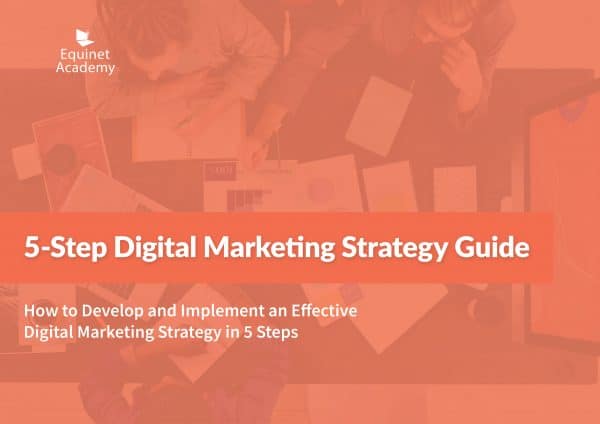
Learn how to develop and implement an effective digital marketing strategy in 5 simple steps.
Equinet Academy respects your privacy and will never misuse or sell your personal information.
By submitting this form, you consent to receive communications from Equinet Academy on exclusive invitations to marketing events, launch of new courses and more. Privacy Policy
In this article, you will gain a foundational overview of digital marketing and what a digital marketing strategy can do for your business.
What is Digital Marketing?
Digital marketing is the marketing of products or services using digital technologies via the internet, social media, mobile phones, or any other digital medium.
It is also an umbrella term that encompasses different marketing strategies such as Social Media Marketing, Search Engine Optimisation, and Email Marketing.
Compared to traditional marketing methods such as print, billboards, and TV, digital marketing is primarily data-driven. Many popular digital advertising platforms today provide access to campaign reports for comprehensive data analysis.
With the combined forces of both the internet and technology, Digital Marketers today are able to collect and analyse data of different customer behaviour or user engagements, enabling them to facilitate more personalised content and advertisements toward clearly defined audiences for better engagement and results.
Why Digital Marketing?
Unlike traditional marketing, digital marketing boasts the following benefits:
Trackable and Measurable
Technological advancements have made it fairly easy to measure the efficacy of marketing campaigns through digital analytics dashboards such as Google Analytics, Google Data Studio, and Adobe Analytics.
Through the deployment of digital analytics, the data collected over a period of time are right at your fingertips. Each and every user interaction (touchpoint) with your business produces its own set of data, allowing you to segment the data and understand how each touchpoint contributes to your bottom line (sales or conversions).
A conversion can be any action a user takes such as downloading a white paper, submitting an enquiry form, or making an online purchase.
From here, you can find out which touchpoints resonate with your target audience i.e. contributed the most conversions, and reproduce this success on future campaigns.
Check out our list of the Top 10 Social Media Analytics Tools.
Efficiency in Optimisation
The emergence of media buying platforms has allowed marketers to purchase ad spaces across various websites and mobile apps and review live reports within hours.
This allows marketers to review ad campaign performance and make tweaks on the fly such as optimising ad creatives to improve audience engagement.
Broad and Targeted Reach
With billions of users on social media platforms like Facebook, YouTube, and LinkedIn, your reach is primarily limited by your budget. Many of these social media platforms also allow you to target your ads to specific audiences e.g. by demographics, and interests, and behavioural patterns e.g. retargeting.
Retargeting is a form of marketing that enables you to show relevant ads to users who have visited certain pages of your website. For example, if a user visited an online shop selling groceries and navigated to a product page selling apples, the grocery shop could target the user with ads related to apples after the user leaves the site and browses other websites, social media platforms, and mobile apps.
3 Pillars of Digital Marketing
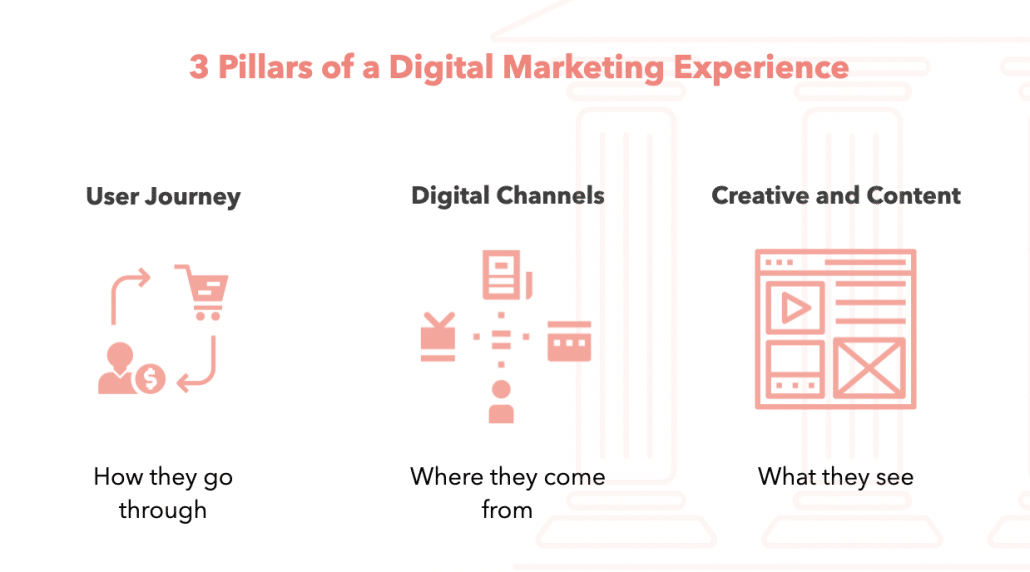
3 Pillars of Digital Marketing
There are 3 Pillars in Digital Marketing. They are:
- User-Journey
- Digital Channels
- Creative and Content
1. User-Journey
The first pillar of digital marketing is the user journey.
The user journey is a customer’s encounter and interaction with your brand across all channels digital and non-digital which shape his emotions and perceptions about your brand.
It typically starts from the awareness stage and ends at the purchase or advocacy (loyalty) stage:
- Awareness: The customer is first aware of the brand.
- Consideration (interest/evaluation): The customer needs to evaluate his decision and consider other brands.
- Purchase (desire/action): The customer is ready to make a purchase.
- Advocacy (loyalty): The customer spreads word of mouth and recommends the brand to his friends.
A customer typically interacts with your creatives or content on various digital channels (social media, search, display ads) and lands onto your website.
When he browses through your website or mobile app, your goal is to encourage him to take important actions which are referred to as conversions, such as filling in a contact form or adding a product to a shopping cart.
2. Digital Channels
The second pillar of digital marketing are digital marketing channels.
A marketing channel is a medium organisations use to communicate or deliver messages to consumers.
In digital marketing, digital channels are avenues where your customers come to know about your business and what it has to offer. This is where your traffic (users) come from.
Examples of digital marketing channels include:
- Organic Search (e.g. Google)
- Paid Search
- Display
- Social Media
- Referral (e.g. Traffic through other websites)
Organic Search
People use search engines for various reasons ranging from research, shopping, to entertainment, with Google alone handling over 40,000 queries per second (3.5 billion search queries per day).
The organic search results appear below the paid search ads.
In order to rank a website on top of the organic search engine results pages (SERPs), marketers implement a digital marketing strategy known as search engine optimisation (SEO).
Paid Search
The paid search ads results appear all the way up at the top of the SERPs.
In order to advertise your website on the paid search ad results on Google, you will need to sign up for a Google Ads account and implement a digital marketing strategy known as search engine marketing (SEM).
Display
The display channel refers to ad placements that appear on webpages when users browse them.
To have your ad appear on website placements, you can start with Google Ads or a demand-side platform.
There are roughly around 4 billion email users as of 2020 – Statista. Email is still one of the most popular mediums businesses use to communicate with their customers today.
Digital marketers implement digital marketing strategies also referred to as email marketing and marketing automation to send targeted and relevant emails to properly segmented email subscribers.
Social Media
Social media needs no introduction. People use it daily to keep up to date with news or connect to friends and family across the globe.
Businesses are on social media to connect to potential customers by engaging them in a more personal and authentic way. With the help of various social media marketing tools, you will be able to understand the needs and interests of your target audience across various social media platforms. This will help you better tailor your content to better engage your target audience.
Referral
Referral traffic acquired are a result of users clicking on hyperlinks (backlinks) and navigating from one website to another (the hyperlink target or website). This means traffic coming from other websites instead of a direct search into Google.
Referral links are forged through strategic online partnerships or as a result of earned media. Implementing online PR is one of the most effective methods to earning brand mentions, acquiring backlinks, and generating brand awareness.
How Do the Different Digital Channels Impact the Business?
These are just a few examples of digital marketing channels, and between what you decide to use, it is important to analyse digital marketing analytics reports to understand which digital channels return the highest investment in order to allocate the right budgets accordingly.
Digital marketing campaigns also usually involve integrating multiple digital channel strategies (multi-channel) such as search engine marketing, content marketing, display advertising, and email marketing.
Do not confuse this with omni-channel, which like multi-channel, also involves engaging customers via multiple channels. Omni-channel is more accurately defined as providing a consistent, unified, and seamless customer experience regardless of whether the customer interacts with a brand on social media, in the physical store, or on the online store.
Physical brochures that in-print QR codes to link the customer back to the online store, and membership systems that tailor product recommendations based on customer purchase history both online and offline are examples of omni-channel strategies.
Digital marketing can and should be integrated with offline marketing channels such as print advertisements, live industry events, popup booths, and in-store promotions to maximise target market reach and lead nurturing.
An example of an online/offline marketing integration would be launching a trade show (offline) and launching a Facebook Advertising campaign (online) to promote the offline event. And during the event (offline), collecting personal details of leads such as emails and phone numbers to follow up through email and mobile marketing (online).
By delivering an omni-channel customer experience across the user journey, all the way from the awareness to the post-purchase stages, businesses can engage their audiences at various touchpoints.
For instance, businesses can launch online PR campaigns to create awareness, implement content marketing to help customers evaluate their products, drive high purchase intent traffic to their website via SEO, digital ads, and email, and nurture leads to repurchase through Email Marketing, Digital Advertising, Marketing Automation, and Social Media Marketing campaigns.
The selection of digital marketing channels depends on a variety of factors such as:
- Marketing objectives: Are your goals to increase brand awareness or encourage purchase?
- Marketing Budget: Do you have sufficient budget to span your marketing campaigns across multiple digital channels?
- Manpower: Does your marketing team have the necessary knowledge and skills to manage multiple campaigns and digital agencies?
- Customers: Which platforms are your customers on? What are your customer touch points?
We discuss different digital marketing channels further in this blog post.
3. Creatives and Content
The third pillar of digital marketing are the creatives and content.
These are content in the form of visual graphics, text, and videos created and marketed by your brand that your customers interact with and digest, also referred to as Content Marketing.
Creatives come in the form of:
- Ad banners
- Video advertisements
- Text ads
While Content comes in the form of:
- Blog articles
- Explainer videos
- Infographics
Read also: 120 Types of Content for your next Digital Marketing Campaign
What is a Digital Marketing Strategy?
A Digital Marketing Strategy is a plan or course of action towards achieving set marketing goals. Goals are determined by what your business objectives are and in order of priority. Once these goals are set, digital marketing campaigns will be developed and executed to achieve them.
A digital marketing strategy is different from a digital marketing campaign. When talking about digital marketing strategy, we are referring to a master plan or a blueprint to achieve a long-term or macro goal. Campaigns on the other hand are the specific tactics used to achieve more micro, short-term goals within the digital marketing strategy.
Why is Having a Digital Marketing Strategy Important?
Having a strategy is about as important as having a plan to achieve any goal. It fully optimises the workflow implementation, allowing high efficacy while overlooking various areas to review data analytics and acting upon them accordingly.
This makes way for continuous improvement in the various digital marketing strategies ranging from search marketing (SEO/SEM), conversion rate optimisation (website user experience), email marketing & social media marketing to build towards your business goal, gaining new customers and building deeper relationships with existing ones.
Your business also needs a competitive and sustainable content marketing strategy to reach and convert more customers through leveraging on the power of online content, while integrating the different digital marketing channels with traditional media.
As organisations begin to recognise the importance of embracing transformation and preparing for it, businesses will continue to adopt digital transformation in their core operations and in new channels of reaching customers. Thus, having a good digital marketing strategy is vital for this success.
Key Components of a Digital Marketing Strategy
Some key components of a digital marketing strategy include:
- Defining the brand: Utilise brand guidelines to define your brand. Consider the Unique Selling Points (USPs) of your business.
- Developing customer personas: Understand demographic information such as age, gender, location, as well as the motivations that drive people to choose the products and services. Use Google Analytics to assist in creating buyer’s persona and segment them according to the keywords in organic traffic
- Defining S.M.A.R.T. (Specific, Measurable, Achievable, Relevant, Time-bound goals.) marketing objectives and KPIs: E.g. Achieve a 20% increase in leads generated from contact form within the next 6 months
- Identifying target markets: Use market research tools such as Google Keyword Planner, Google Trends, and Facebook Audience Insights to conduct market research and identify potential target markets
- Performing competitive analysis: Use web and social analytics tools such as similarweb, Semrush, and SocialBakers to analyse your competitors and conduct a SWOT analysis.
- Managing and allocating resources appropriately to achieve objectives: Resources include manpower (in-house team or outsource, external marketing agencies) and budget.
- Reviewing and optimising campaign performance: Use digital marketing analytics tools such as Google Analytics to track, measure, and report your digital marketing campaigns’ performance
These are just some of the components of a digital marketing strategy.
How Do You Develop a Digital Marketing Strategy?
A digital marketing strategy involves setting marketing objectives based on the analysis of market information and target audiences, selecting digital marketing channels and platforms, determining channel-specific delivery tactics, and defining macro marketing KPIs to measure the performance of the digital marketing strategy.
On the other hand, an example of a digital marketing campaign centres around creating brand awareness (micro objective) through launching a viral marketing campaign (tactic) on a specific social media channel like Facebook. Short term (micro) KPIs are used to keep track of the progress and success of the digital marketing campaign.
Before developing any digital marketing campaigns, you should first have a strategy. Part of the strategy includes creating a customer journey and touchpoint map that looks something like this:
This map will act as a key reference document when determining which digital marketing channels to target and which digital marketing tactics your team should execute.
The implementation process of a digital marketing strategy which we cover in our 2-day digital marketing strategy course looks like this:
For a more comprehensive example, check out a digital marketing strategic plan sample completed by one of Equinet’s graduates from the Certified Digital Marketing Strategist (CDMS) programme.
You may also download a free digital marketing strategic plan template (Word Doc) to start planning a digital marketing strategy for your business.
Digital Marketing Examples
There are many types or categories of digital marketing. Examples of digital marketing include:
- Social Media Marketing (SMM)
- Search Engine Optimisation (SEO)
- Search Engine Marketing (SEM)
- Email Marketing
- Marketing Automation
- Digital Advertising
- Content Marketing
Let’s have a look at how Equinet Academy integrates and implements several Digital Marketing Strategies such as SEO and Content Marketing, Email Marketing, and Social Media Marketing.
In the Awareness stage:
- Equinet markets the Digital Marketing Career Handbook to aspiring digital marketers via Facebook sponsored posts. (Social Media Marketing and Content Marketing)
- Equinet also ranks on top of Google for digital marketing career-related keywords such as “digital marketing career progression” and “digital marketing salary singapore”. (Search Engine Optimisation and Content Marketing)
In the Evaluation stage:
- Equinet sends out emailers to subscribers on the upcoming course schedules. (Email Marketing)
- Equinet also has a course recommendation tool for users to answer questions and receive course recommendations (Content Marketing)
In the Purchase stage:
- Equinet runs retargeting campaigns by targeting display and social media ads to users who have visited any course pages. (Digital Advertising and Social Media Marketing)
- Equinet also ranks on top of Google’s organic and paid search results for course-related keywords such as “digital marketing courses” and “seo course singapore”. (Search Engine Optimisation and Search Engine Marketing)
In the Advocacy stage:
- Equinet emails course followup surveys to graduates of each course and sends followup reminders to attend group mentorship sessions. (Email Marketing and Marketing Automation)
In the above example, you can see that multiple digital marketing strategies and digital channels are applied in an integrated manner throughout different phases of the user journey.
Also, creatives and content are present at every stage of the user journey, allowing users to interact with the ads, emails, and website content.
You can view more digital marketing examples in our case study resource library.
Summary
The overall digital marketing strategy can be summed up into this framework:
The user journey or buying funnel starts from the awareness stage and progresses down to the interest (evaluation/consideration), action (purchase) and loyalty stages.
Throughout the user journey, the customer interacts with the brand via different digital channels (organic search, social media, email) and takes actions via CTAs or calls-to-action on ad creatives or website content (e.g. landing pages).
If you want to learn more on how to develop and implement a digital marketing strategy, sign up for our digital marketing strategy course or browse our range of digital marketing courses held in-person in Singapore, or online, across multiple digital marketing disciplines, channels, and platforms.
However, if you aspire to be a Digital Marketing Strategist, we have a pathway to complete all 6 core modules.
Not sure which course to take? Check out our course selection tool now. Complete a 3-question survey and determine the course suitable for your needs.

Zhong Li is the founder of Mikangle, a digital transformation company that focuses on advisory, training, and investment. He is also the Co-founder and now Advisor of Finty, an online financial marketplace that was acquired by an Australian firm, 15 months after the company was launched.
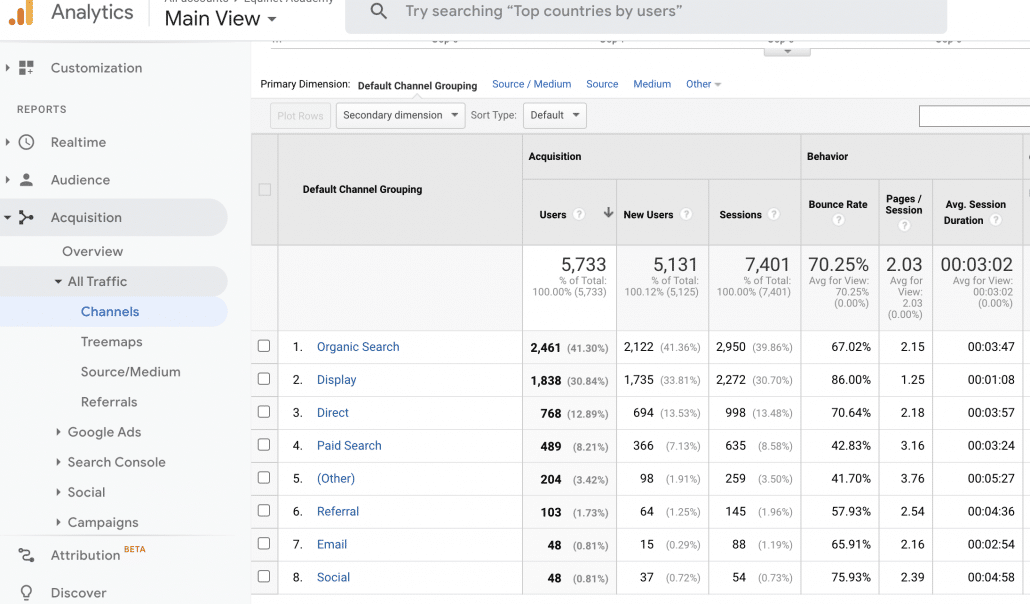

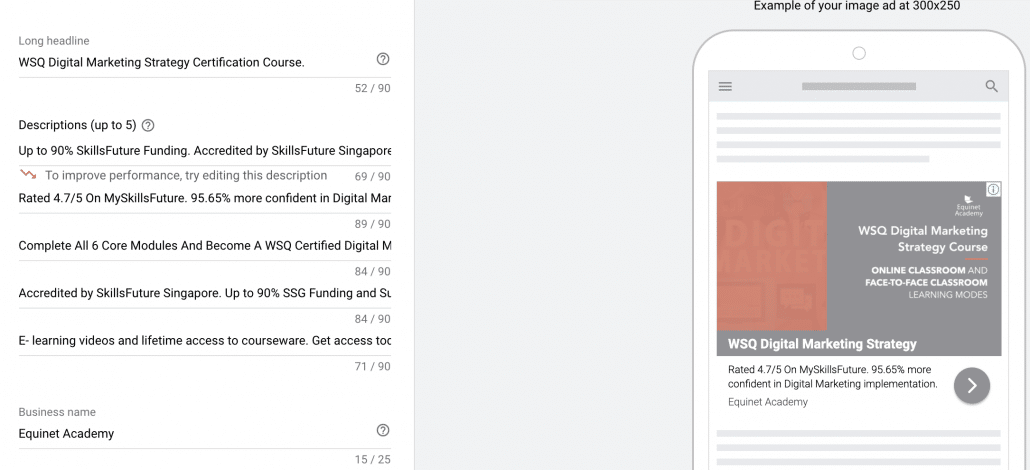
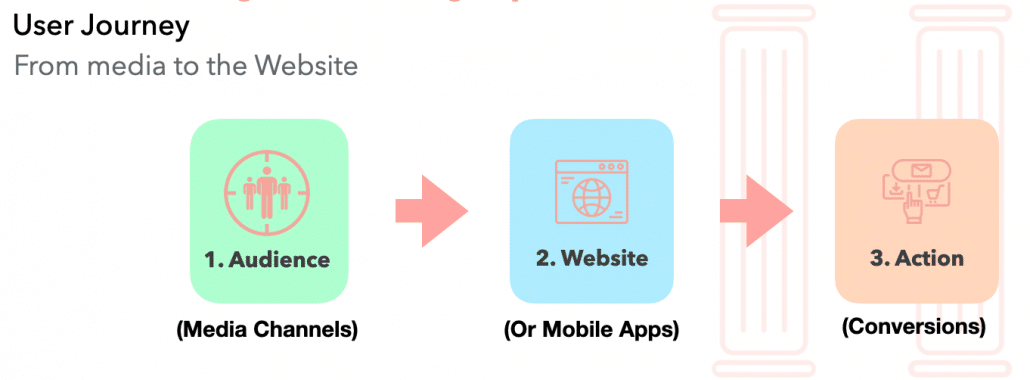
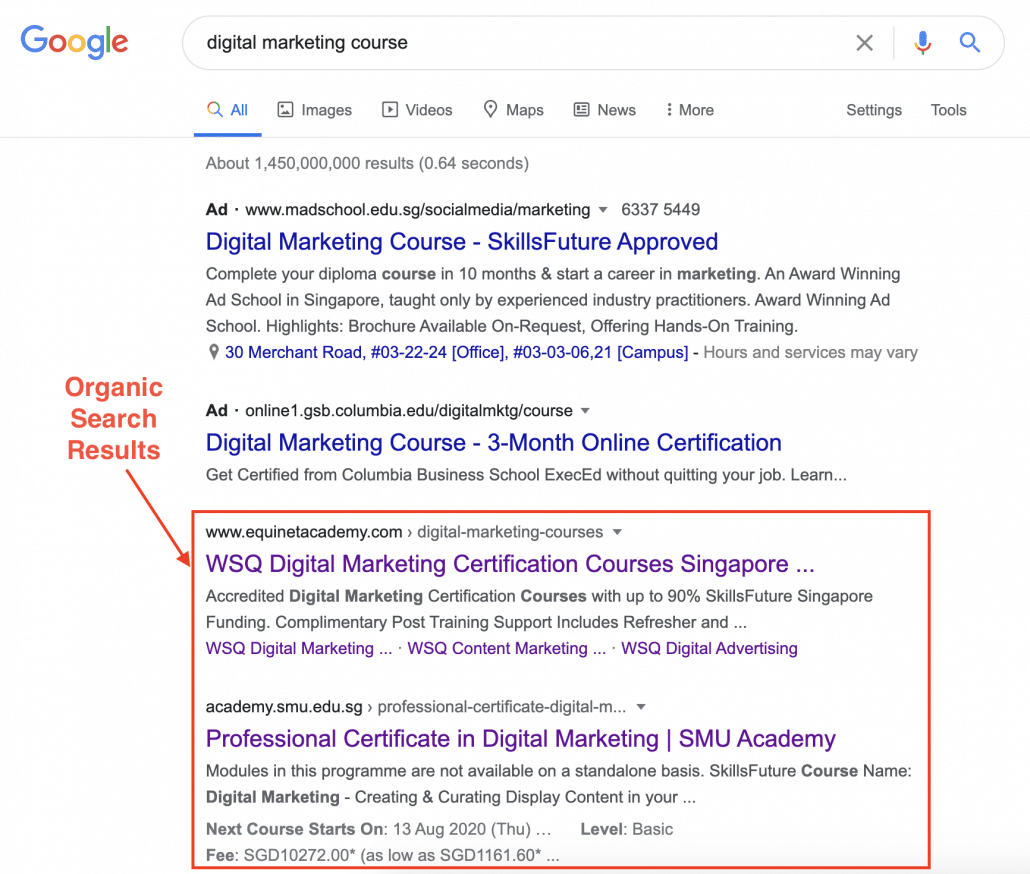
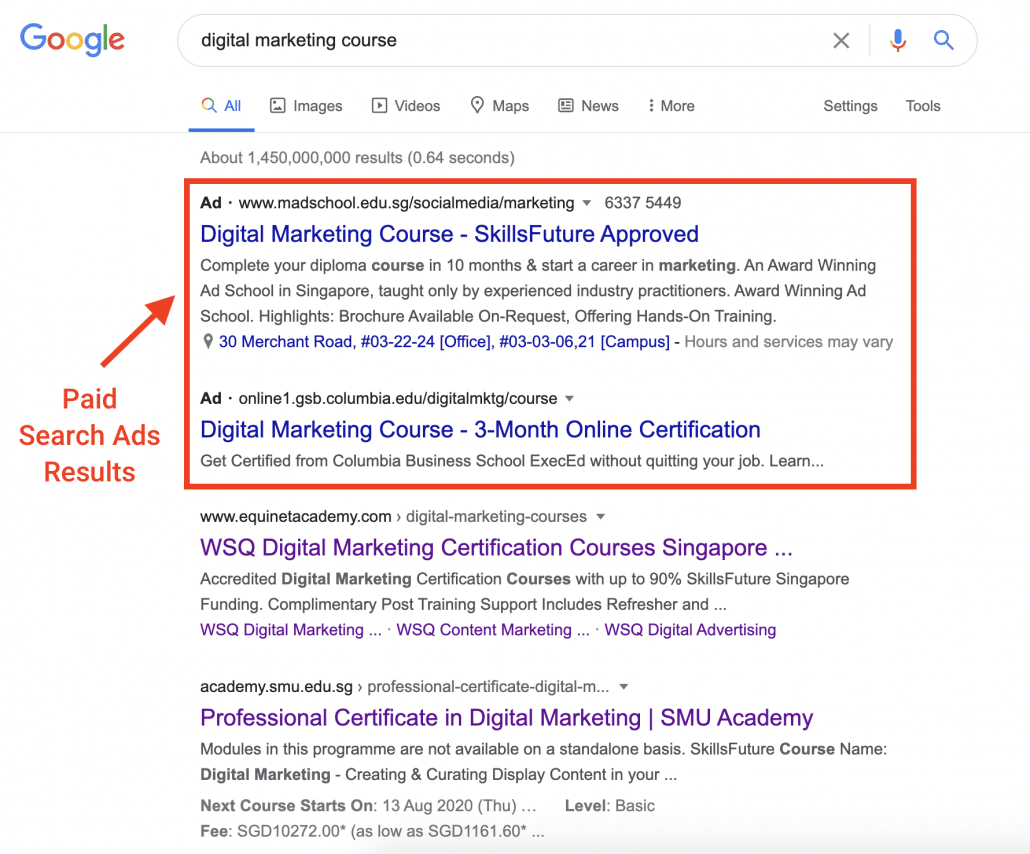
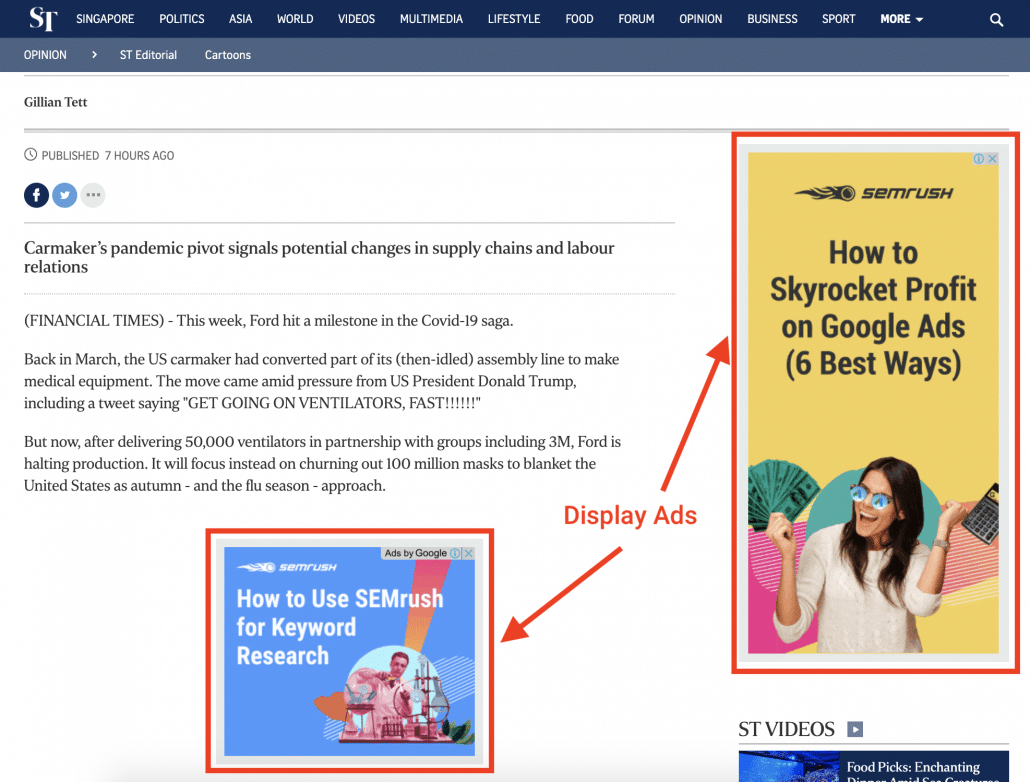
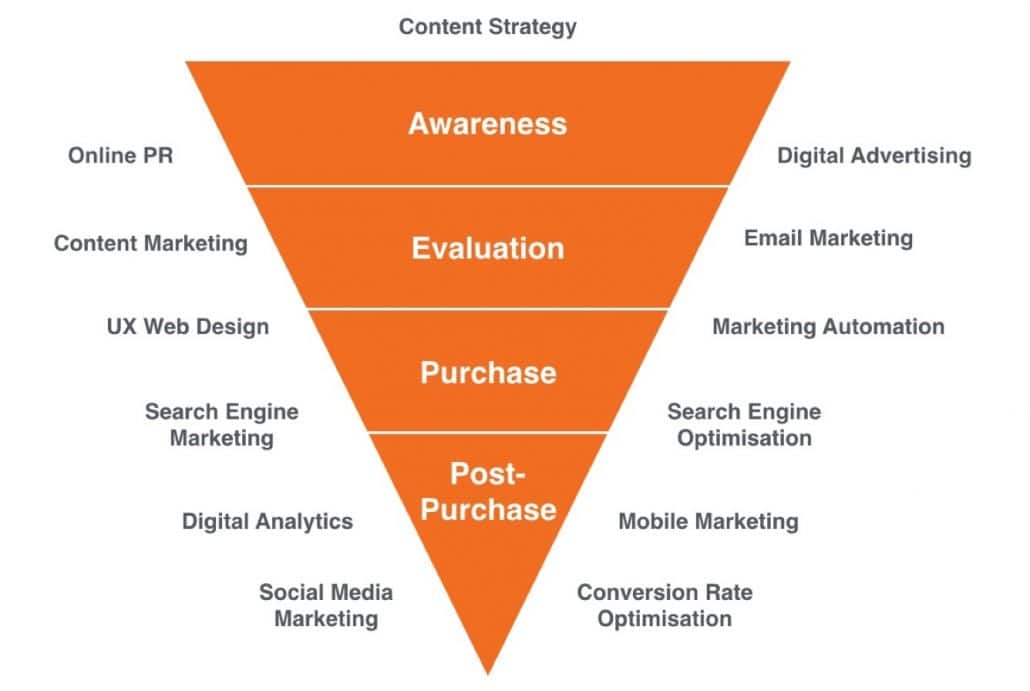
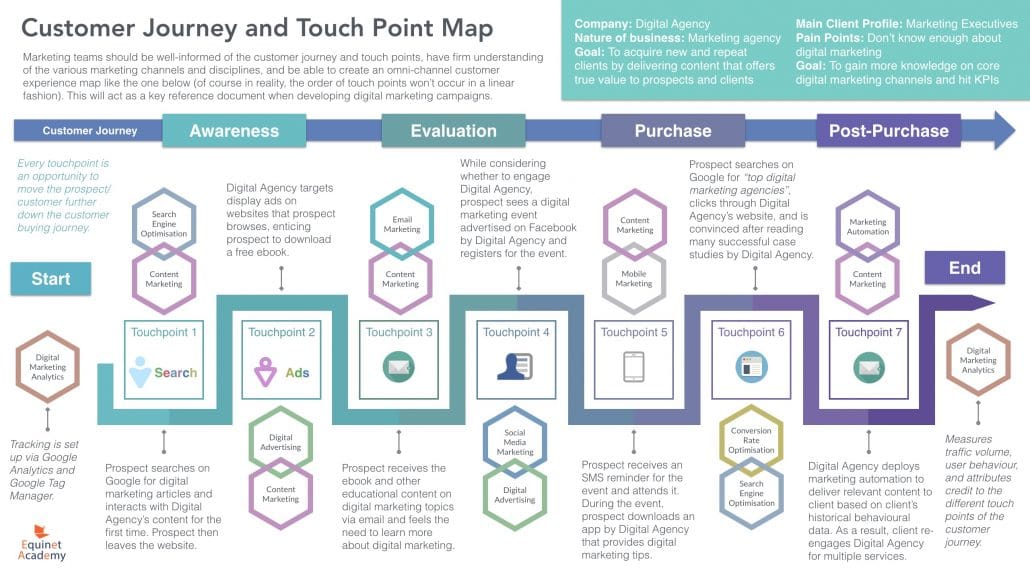
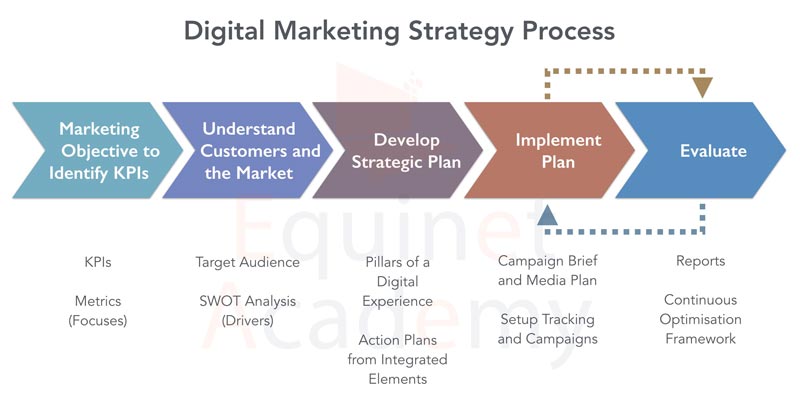
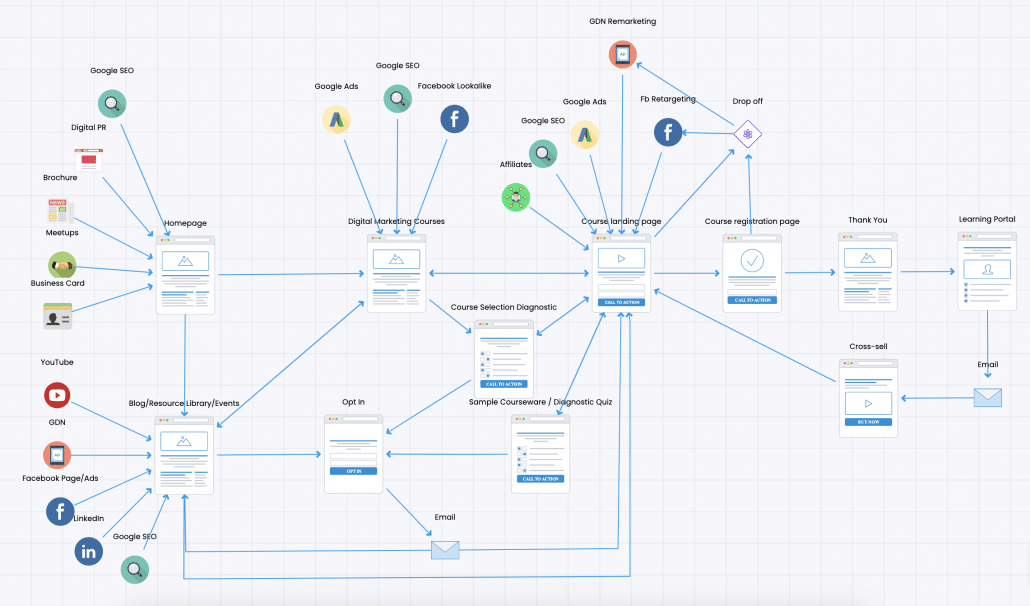
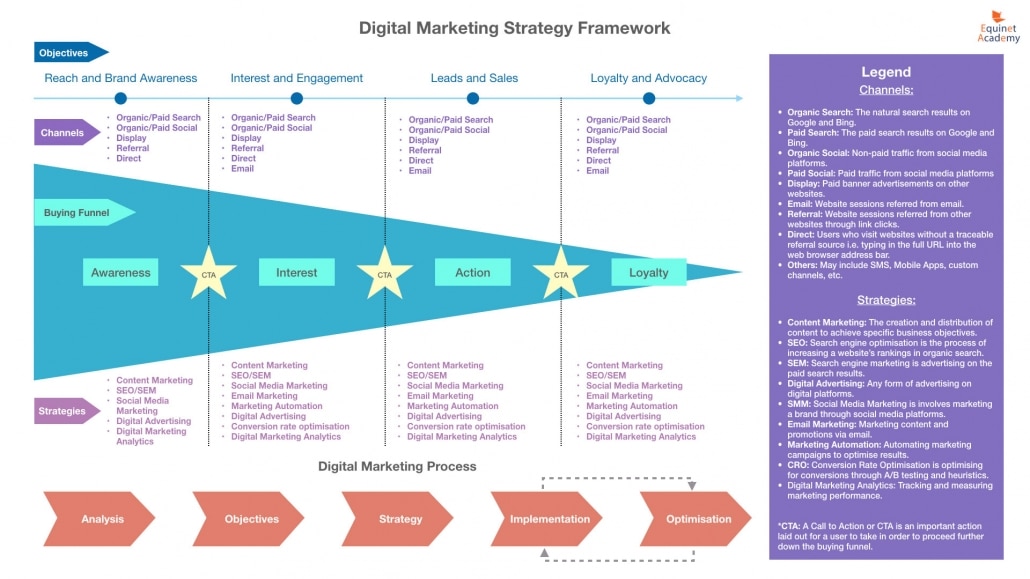
Wonderful , detailed explanation , but you said :”Digital marketing can and should be integrated with other forms of marketing including traditional and offline marketing strategies ”
Is this necessary all the time ?
Thanks for stopping by Ero. In my opinion, most businesses should include a holistic marketing strategy which includes offline methods as well. For my company, Equinet Academy, we host offline meetup events on top of other digital marketing tactics. We then track and attribute course signups to various marketing channels (online and offline).
Then again, whether it is necessary or not depends on your business model and niche. In the real estate industry for example, billboard and buntings are still a great way to drive awareness to a new launch project, but are best complemented with social media advertising and search engine marketing.
Thanks for sharing such an informative article about Digital Marketing. A digital marketing strategy is vital for every business looking for further growth.
Great explanation on digital marketing strategy. It has helped me better understand what digital marketing is from a beginner’s point of view.
Nice content! Thank you for sharing your ideas about digital marketing.
Thanks for sharing a wonderful content for digital marketing with examples
Thanks for sharing the great article about digital marketing
That was the most valuable article I read about digital marketing. Thanks. I understand the process better now.
Hi, Kwok Zhong Li,
Really nice information to have.. You have done fantastic job spend you valuable time to look out for all these blogs and shared with us. Highly appreciated.
Very informative read, Kwok! Digital marketing, often known as online marketing, is the marketing of businesses through various digital media to interact with potential clients. This encompasses social media, e-mail, and internet advertising, but it also covers text and multimedia messaging as a promotion tool.